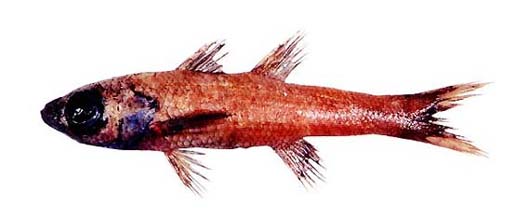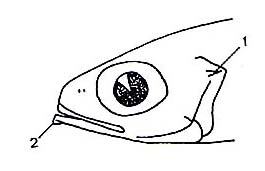テンジクダイ科
- HOME
- デジタル図鑑
- パタゴニア海域の重要水族
- 硬骨魚綱 スズキ目
- テンジクダイ科
テンジクダイ科(Apogonidae)

72 マルヤセムツ(Maru-yasemutsu)
Epigonus robustus (Barnard, 1927)
特 徴:
背鰭7棘,1小棘,9軟条,臀鰭2棘,9軟条,胸鰭15軟条,腹鰭1棘,5軟条,鰓耙数10+1+21=32,鰓条骨数7,脊椎骨数11+14=25,側線鱗数57。頭長は体長の30.6%,眼径は9.3%,体高は19.6%,吻長は6.4%,両眼間隔は6.6%,上顎長は13.1%,尾柄高は10.7%,胸鰭長は17.6%。体は延長し,やや側扁し,体長は体高の約6倍。頭は大きく,体長は頭長の約3.5倍。眼は大きく,頭長は眼径の約3倍で,眼径は吻長より長い。口は斜位で,わずかに伸出可能。上顎後端は瞳孔前縁下に達する。下顎は上顎より前方に突出し,下顎先端に小突出物がある。上顎は無歯。微小な1列の円錐歯が下顎前半部にあるが,後半部は無歯。多数の微小円錐歯が鋤骨上にある。口蓋骨は無歯。舌上に歯はない。鼻孔は一対で,両鼻孔は円形で小さく,相接近して位置する。主鰓蓋骨棘は化骨がよく強い。鰓耙は長く錐状。両眼間隔域はほぼ平坦で,その幅は吻長とほぼ等しい。擬鰓がある。鱗は大きな櫛鱗で,側線部以外は脱落し易い。側線は単線で,躯間部では背縁に近く,ほぼ平行に走り,尾部では体の中央を走り,尾鰭基底部で終る。胸鰭は低く位置し,腹鰭よりわずかに長い。腹鰭起部は胸鰭基底部後縁下に位置する。第1背鰭,第2背鰭および臀鰭の基底は短い。尾鰭はわずかに二叉する。体色は背方が褐色で腹方が淡褐色。体に多量の脂肪を含む。
分 布:
ブラジル南部からアルゼンチン パタゴニアにかけての南米東岸沖;南アフリカとタスマニアからも知られている(Mayer, 1974)。
備 考:
今までのところ世界中から12種のEpigonus属魚類が知られている(Mayer, 1974)。
(中村 泉)
Material examined:
1 from Argentina (149.0 mm SL), FAKU AP 761.
Description:
D Ⅶ, i, 9; A Ⅱ, 9; P1 15; P2 Ⅰ, 5; GR 10+1+21=32; BR 7; Ⅴ 11+14=25; LLS 57. Hl 30.6 of SL; ED 9.3; BD 19.6; SN 6.4; IO 6.6; UJ 13.1; CP 10.7; P1L 17.6.
Body elongate, moderately compressed, body depth about 6 times in SL. Head large, about 3.5 times in SL. Eye large, about 3 times in HL, longer than snout. Mouth oblique, slightly protrusible, maxilla extending to anterior margin of pupil. Lower jaw protruding anterior to upper jaw, bearing a small nub on anterior tip of mandible. No teeth on upper jaw, fine conical teeth uniserial on anterior part and no teeth on posterior part of lower jaw. Many fine conical teeth on vomer. Palatines edentate. No lingual teeth on tongue. Nostrils paired, both small and circular, closely situated each other. Opercular spine well ossified and pungent. Gill-rakers long, awl-like. Interorbital region fairly flat, its width about as long as snout. Pseudobranchiae present. Scales large ctenoid, deciduous except lateral line scales. Lateral line single, extending nearly parallel to dorsal profile on dorsolateral part of trunk, descending to midline on posterior part of caudal peduncle, ending at caudal base. Pectoral fin low, slightly longer than pelvic fin. Pelvic fin situated slightly behind posterior insertion of pectoral fin. Base of first dorsal, second dorsal and anal fins short. Caudal fin weakly forked. Body brown above and paler below. Body very oily.
Distribution:
Atlantic coasts of South America, from southern Brazil to Argentine Patagonia; also known from off South Africa and off Tasmania (Mayer, 1974).
Remarks:
There have been known about 10 species of Epigonus (telescopus, macrops, pandionus, fragilis, occidentalis, denticulatus, oligolepis, trewavasae, pectinifer, and lenimen) plus 2 species described here (Mayer, 1974).
(Izumi NAKAMURA)

Distribution of Epigonus robustus in Patagonia.

Head with an opercular spine (1) and nub-like lower jaw tip (2).
- 1
- 2